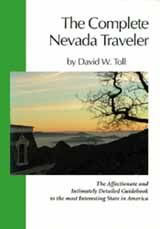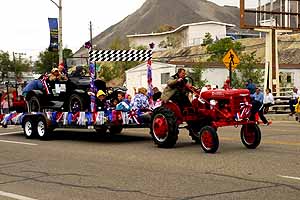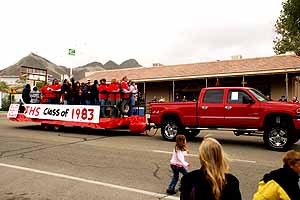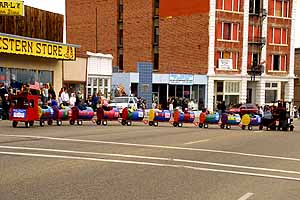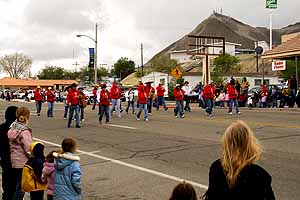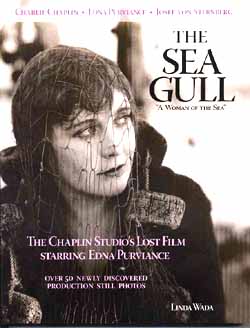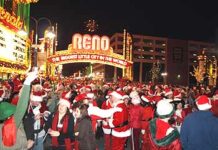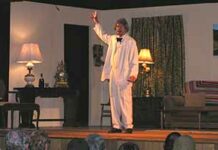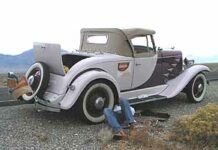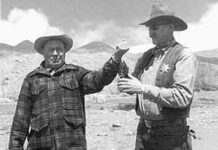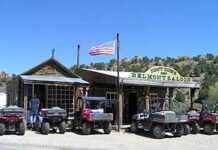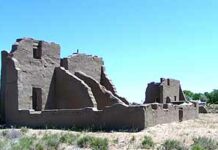What They’re saying About Us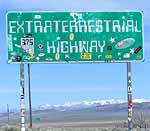 The New York Times drives the Extraterrestrial Highway. |
| Sign Up for our NevadaGram here. |
May was Historical Preservation month. I spent most of it preparing the new edition of The Complete Nevada Traveler for the printer, and in the process I was struck by the way the old Nevada is slowly — and not so slowly — disappearing.
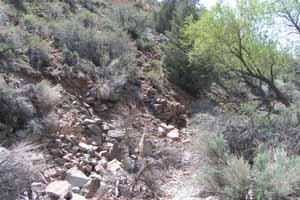
It has been happening for many years, and it happens in big ways and small. In Reno and Las Vegas, landmark structures are being demolished. In Silver City a rock wall fell down.
Granted, both the Mapes Hotel in Reno and the Stardust on the Las Vegas Strip, the most recent landmarks to be scraped away, were beyond redemption as profit centers. They had become old and in the way, preventing the high-priced real estate they occupied from realizing its prime purpose, and so they had to go. Generations of memories went with them.
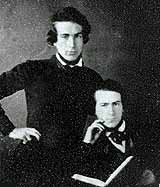
That rock wall in Silver City is a more complicated case. It had been built more than a century and a half ago by two brothers from Pennsylvania, Allen and Hosea Grosch, who had come west as ’49ers. As they packed their way across the Isthmus of Panama, they met a man who had ranged north from Mexico with a prospecting party. He told them about a region far to the north where silver abounded, and told them how to find it. After a season in the California placer mines they had crossed the Sierra to Nevada, following the directions they’d been given, and found a small population of prospectors panning gold from the little creek flowing down Gold Canyon to join the Carson River at present-day
Like their neighbors they built a rough cabin, dry-stacking rock against the wall of American Canyon, where a tributary stream feeds into the main channel of Gold Creek, and building the other walls and the roof of logs and limbs. In 1856 they wrote home, “Native silver is found in Gold Cañon; it resembles thin sheet-lead broken very fine, and lead the miners suppose it to be.” Later they wrote, “One of these veins is a perfect monster.”
But before they could record or develop their claims, Hosea drove a pick through his foot and died of blood poisoning. Allen then struck out on foot for California, but was caught on the Sierra by winter snows and died of exposure.
| Their little cabin had been left in the care of Henry Comstock, “a lazy, drunken prospector” (as one historian described him), who took possession of their possessions, including a trunk containing documents and correspondence. These papers were never brought to light, and it was Comstock’s name that was attached to the great discoveries of gold and silver that followed: the Comstock Lode. |
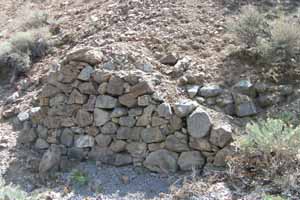 The back wall of a neighboring cabin remains intact on Main Street, Silver City. |
As the mines were developed, Virginia City soon became the greatest city between San Francisco and Denver, Gold Hill was renowned for its rich mines and Silver City, which took form just uphill from the Grosh brothers’ crude cabin, attracted over 1000 residents. The little cabin, long abandoned, fell into disrepair. Its wooden parts were doubtless scavenged by other miners to burn for heat one freezing winter. But through the years of bonanza, and the borrasca that followed, as the generations succeeded one another, the significance of the stacked rocks was forgotten. No plaque, no-one left to remember. Yet the wall remained intact.
Until last spring, when it tumbled down into a heap, and the last remaining handiwork of the men who located the Comstock Lode became just a meaningless jumble of rocks.
Around the state there are many historic treasures that are being protected, restored and revived. But at the mouth of American Canyon a big piece of our history was lost when that little wall came down.
Nevada has lost one of its best. Gene Kaplan has died.
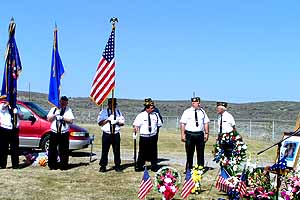
He and his wife Peg moved to Wells from San Francisco and immediately began to invest themselves in the old city on the northeastern frontier. They bought the defunct El Rancho Hotel, lived upstairs and put the downstairs to use for public meetings and private events, bought several of the historic buildings on Front Street, including the iconic Bulls Head Bar, cleaned up the facades and began restoration. He did deep research and put informational placards on each of the old structures, providing visitors with a pleasant and instructive promenade as they read of the San Marin Hotel, the Elite (pronounced in properly contrarian Nevada fashion as ‘Ee-light’) Saloon, the Goble Market, the Mint Saloon, the Soya Lung Chinese Merchandise store and more.
His Walking Tour brochure of Old Town Front Street brought old Wells to life. “It was 1883 when Death Valley Scotty stepped off a train in
the middle of the night. It was dark and cold,’ Scotty later told Eleanor Jordon Houston who collected his reminiscences for her Death Valley Scotty Told Me. ‘The next morning,’ Scotty related, ‘I began to look around. Everybody I saw had a pistol — engineer, station agent, baggage man, conductor, cowboys, even women.’
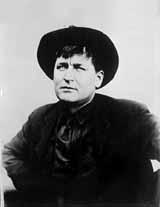
Scotty learned brother Warner had gone north leaving him pretty much on his own at age 11, although arrangements had been made with a Front Street hotel to board him. Soon thereafter Scotty met a girl named Katie and together they sold milk and doughnuts when emigrant trains stopped in Wells. At least one Front Street restaurant operator resented their competition and made it ‘unpleasant’ for the two entrepreneurs. Seeking revenge to back off those pressuring him, Scotty waited until passengers were almost finished eating, then opened the restaurant door to shout, ‘All Aboard!’ That caused patrons to jump up and run out without paying.
Books about the Comstock Lode
|
E-Mail of the Month
Jim Butler Days in Tonopah  We had a great time at Jim Butler Days. On Friday night, we joined quite a few durable locals and attended the street dance. It was cold temp (it was probably in the high 40s to low 50s). I know it wasn’t too cold because my kids still ate some snow cones. Also, I was able to wear my traditional Tonopah garb that consists of shorts, sandles with socks and a parka. After that, my wife and I joined many local alums from all the classes of the 90s (include the classes of 83 and 88 that were having reunions) at the Tonopah Liquor Company. We caught up and heard the usual variety of hilarious Tonopah tales. I’ve never before seen so many beards and hats in one room.
On Sunday, there was a light snow on the mountains around town. It was beautiful and a real treat for my kids since we don’t see much snow in Boulder City. We were able to go catch some of the arm wrestling contests. They wouldn’t let me compete (mainly because I wanted to compete against small ladies or children). However, we did get to see more of the Pahrump Gunfighters.
|
“Sometimes when passengers showed no interest in what Scotty and Katie were selling,” Gene wrote, “they’d wait until the train was about to pull out. Then Katie would cut loose with war whoops. As passengers stuck their heads out of car windows to take a look, Scotty ran by with a stick to knock hats off. The train pulled out with surprised bareheaded passengers, and Scotty peddled hats for two bits each when the next train pulled in.”
There’s more, lots more, of Wells and its fascinating cast of characters that he brought to life. Then the February earthquake bucked beneath the old city and damaged the El Rancho badly, perhaps beyond repair. It devastated the block of Front Street that Gene and Peg had worked so hard to restore. They moved to a motel, and then to a hospital in Salt Lake City. And then he was gone. Thank you Gene, for caring so much and for doing so much.
And while Gene was working so hard to express the rich reality of his adopted home, here’s an example of the ignorance he was contending against (from a blog Travels With Jeff & Mutton): “. . . It’s hard to describe the ‘middle part’ of Nevada. You can’t make comparisons, because to do so would be to relate one thing that is known to something in Nevada that isn’t known, but there is nothing IN Central Nevada to make comparisons to. There’s just nothing there. You’d have to compare it to some artificial environment only possible under laboratory conditions. It’s like quantum mechanics. You can measure the Middle Part of Nevada but you cannot observe it, for there is simply nothing to observe. But then, one comparison did come to mind. If I had seen one of the Mars rovers next to me at a gas station, I would have just shrugged.”
|
In my Bookbag — The Sea Gull by Linda Wada.
As every Nevada schoolchild knows, Edna Purviance was born in Paradise Valley and grew up in Lovelock before heading off for the bright lights of San Francisco and becoming a movie star. She was Charlie Chaplin’s leading lady, on-screen and off, co-starring in more than 40 of the movies that brought him worldwide fame. But what even some schoolchildren don’t know is that after being replaced both onscreen and off by younger women (in some cases, barely pubescent girls), she starred in movies of her own. The first of these was “A Woman of Paris” in 1923, which Chaplin directed with Adolphe Menjou as her co-star The second was the 1926 production “The Sea Gull”, produced by Chaplin and directed by the then-unknown Joseph von Sternberg. It was never released, and in 1933 Chaplin burned the negatives. Little remained from the movie until author and Edna researcher Linda Wada, who has created an encyclopedic Edna Purviance website made contact with Edna’s grand-niece Ellie Hill and discovered, among other priceless Edna memorabilia, a set of more than 50 8×10 photos taken by an unknown photographer during the filming of “The Seagull”. “No words can ever describe my feelings at seeing these pictures for the first time, she writes in her heartfelt and authoritative book about the film and its participants. And indeed, the photographs are marvels of clarity and composition, revealing the story of the film, fleshed out in Wada’s commentary by excerpts from the shooting schedule, the title slides and other documentary sources from her research. This book fills a small niche in the Nevada bookcase, spotlighting a Nevadan we can all enjoy, via Netflix if no other way, and throwing light also on a film otherwise lost to history. “The film has been the last missing chapter in the history of Charlue Chaplin, the producer, Josef von Sterberg, creator and director, and Edna Purviance, the star”, Wada writes. “The photographs Edna kept may be the only remaining record of The Sea Gull, perhaps the last chance to see anything of the film Chaplin chose to forget, and Edna wanted to remember.” Her book is beautiful, informative and edifying all at once. It is available at her website and at our online Nevada Book Store. |
Quick notes from beyond the mountains:
Laughlin/Bullhead International Airport (Airport code: IFP a.k.a International Fun Place!) recently underwent a $3 million facelift and expansion. Now Vision Air of Las Vegas is flying a daily charter service to Laughlin from Carlsbad CA and Mesa AZ . . . Each July, Reno is
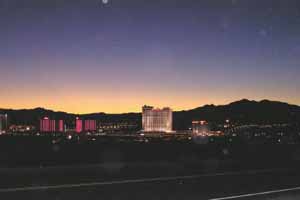
Artown, the nation’s most comprehensive arts Festival, bringing artists from down the street, across the country, and around the world for a month-long celebration of cultural diversity and artistic innovation. 350,000 people experience the more than 350 events. The Little Book of Artown, the free pocket guide covering the 31 days of July, for all that is Artown, is now available at the Artown office (300 E. Second St.), the Nevada Museum of Art, City Hall, (1 E. 1st. St.), and all Washoe County Libraries and U.S. Bank locations. Covering all 31 days of July, the Little Book of Artown is a one-stop guide to the more than 350 events held at more than 100 locations. The 2008 calendar boasts on average seven free events each day. For more information call 775-322-1538 . . .
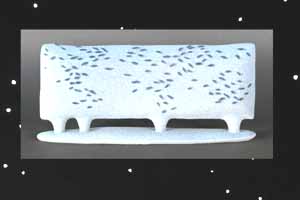
But you don’t even have to wait until July for art events in Reno. From noon to midnight June 26th – 29th 50 rooms of both classic Hotel El Cortez and TownHouse Motorlodge (2nd & Arlington) have been taken over to present a survey of what contemporary art in Nevada is doing, bringing some of Nevada’s hottest and brightest artists together at one time. You’re invited to enter these independent motel room/galleries hosted by the artists bringing art chaos and meaningless order at the Nada Motel . . . I don’t know if it’s art, but ‘Weird Al’ Yankovic, the king of pop parody, returns to the Henderson Pavilion (200 South Green Valley Parkway) by popular demand June 27 at 8 pm for a one night only concert from the ‘Straight Outta Lynwood Tour’. Weird Al will perform his greatest hits including “Like a Surgeon” and “Eat It.” Tickets are $26, $36 and $50; phone 702-267-4TIX . . .
Boulder City will soon be the home of Bootleg Canyon Flightlines, a new attraction which carries thrill-seekers down a series of overhead cables that start at the crest of the mountain range between Boulder City and Henderson. Bootleg Canyon Flightlines consists of a multi-run and multi-line series of lines that range in length from 1150 to 2550 feet. After guests assemble at the base for orientation, training will be provided on an 833-foot long practice run that will allow them an opportunity to become familiar with the system. The practice run will also give anyone having second thoughts a chance to back out before being committed to the full tour experience. But for most it will only heighten what lies ahead. Afterwards, groups of approximately 12 guests are shuttled up to the top of Red Mountain where they begin their descent on a series of 4 lines flying across canyons at speeds of up to 50 mph. The entire tour package will last approximately 2.5 hours and covers a total of 1.56 miles . . . The National Automobile Museum in Reno has the 1907 Thomas Flyer that won the 1908 New York to Paris Race on exhibit. The Museum is at 10 S. Lake St. in Reno and is open Monday – Saturday from 9:30 am to 5:30 pm, and Sunday from 10 a.m. to 4 p.m. Admission is $10 for adults, $8 for seniors and $4 for children 6 to 18 years. Children age 5 and younger are free, and so is parking . . . The Café at the Liberace Museum on Las Vegas offers “Lunch with Liberace” (a sandwich on a large croissant roll, chips, beverage and dessert) for $10, or a snack and beverage for $5 on Thursdays and Fridays. You don’t have to pay admission to the museum to stop by and have “Lunch with Liberace” or shop in the Museum Store. It’s best to call ahead to 702-798-5595 ext 14 or 15 to make sure it’s available when you want to visit.
Overheard at the cemetery in Wells: “Unfortunately every good idea eventually deteriorates into hard work.”
Happy Highways,



